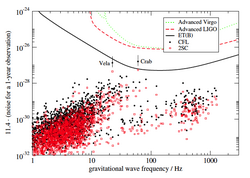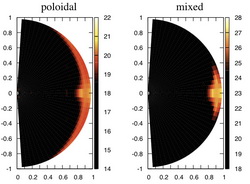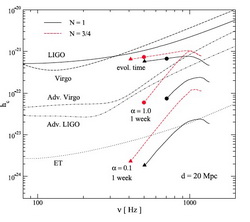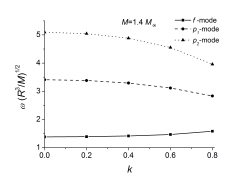Forschung 2012
Probing exotic matter with gravitational waves from neutron star "mountains"
April 2012
Kostas Glampedakis, Ian D. Jones, Lars Samuelsson
Rotating neutron stars can become potent sources of gravitational radiation if their shape can be made non-spherical and non-axisymmetric. Such deformations (colloquially known as "mountains") can be induced by forces internal to the star, for example, by the strong stellar magnetic field.
The expected magnetic deformation is typically too small to make any known neutron star detectable by present and next generation gravitational wave detectors, however, as we have recently shown the presence of stable quark matter in neutron star interiors could be a game changer. Internal magnetic mountains induced in a "color-superconducting" quark core could make young pulsars, like the Crab and Vela, "visible" sources of gravitational waves, hence providing us with evidence of the existence of exotic matter inside these extreme objects.
Phys. Rev. Letters 109, 081103 (2012) arXiv e-print (arXiv:1204.3781)
Are there any stable magnetic fields in barotropic stars?
April 2012
Sam Lander, Ian D. Jones
We only observe the exterior magnetic fields of stars; for neutron stars we can typically just infer the dipole component, from the rate at which the star's spin rate decreases. By contrast, knowing the interior field would help us understand many phenomena of neutron stars: their long-term evolution, oscillation modes and occasional dramatic flaring events. Without having direct observations, we can try to model the magnetic field inside a neutron star - a good model should be a stable equilibrium solution.
Much previous literature has assumed that a barotropic star - where the pressure is a function of density - is a good first approximation. In this case, the expectation was that a magnetic field geometry combining poloidal and toroidal components would be stable. We used numerical simulations to show that this assumption was generically wrong - the magnetic fields were unstable! Our work suggests that more advanced modelling may be crucial to finding a good model of a magnetised neutron star.
MNRAS, 424, 482 (2012) arXiv:1202.2339v1 [astro-ph.SR]
Nonlinear viscous damping and gravitational wave detectability of the f-mode instability in neutron stars
February 2012
Andrea Passamonti, Kostas Glampedakis
Non-axisymmetric oscillations in rapidly rotating neutron stars can be driven unstable by gravitational-wave radiation via the CFS instability [see A. Passamonti et al. (2013)]. The fundamental mode (f-mode) is one of the main candidates which can suffer this instability and emit a copious amount of gravitational waves.
Among the various processes which can limit the growth of the f-mode is the non-linear bulk viscosity. The non-linear terms can be activated during the instability when the mode reaches a significant amplitude.
Our results show that non-linear bulk viscosity has a moderate impact on the size of the f-mode instability window, becoming an important factor and saturating the mode’s growth at a relatively large oscillation amplitude. In addition, we show that the action of bulk viscosity can be significantly mitigated by the presence of superfluidity in neutron star matter. We show similarly that non-linear bulk viscosity leads to a rather high saturation amplitude even for the r-mode instability.
Considering an f-mode-unstable neutron star located in the Virgo cluster and assuming a mode amplitude at the level allowed by bulk viscosity, we find that the emitted gravitational wave signal could be detectable by advanced ground-based detectors such as Advanced LIGO/Virgo and the Einstein telescope.
MNRAS, 422, 3327 (2012) arXiv:1112.3931v1 [astro-ph.SR]
Models and dynamics of alternative neutron star models
May 2012
Stoytcho S. Yazadjiev and Daniela D. Doneva
In modeling the neutron star interior we are forced to make certain assumptions about the properties of the neutron star matter. Some of these assumptions seem to be natural from a physical point of view, however, there are always uncertainties and suspicions that the assumptions may not be fully correct. As the science history shows there are surprises sometimes - Nature does not always share our notions for "natural". That is why the alternatives should also be investigated.
There are many alternatives to the standard neutron star models. What we considered in our work is neutron stars with anisotropic pressure and mixed neutron-dark-energy starts, i.e. stars containing both normal matter and dark energy. We study the properties of the stars and their stability. As these objects are very compact, their oscillations can produce a significant gravitational wave signal. That is why we study also the oscillation frequencies and the deviation from the standard neutron star models. Thus if gravitational waves from oscillating neutron stars are observed in the future, we can potentially determine the presence of dark energy in the compact objects, or set constraints on the anisotropy in the neutron star interior.
Phys. Rev. D 85, 124023 (2012) arXiv:1203.3963 [gr-qc]
J. Cosmology Astropart. Phys. 1203, 037 (2012) arXiv:1112.4375 [gr-qc]




